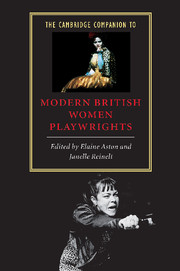Book contents
- Frontmatter
- 1 A century in view: from suffrage to the 1990s
- Part I Retrospectives
- Part II National tensions and intersections
- Editors’ note
- 5 The politics of location
- 6 Contemporary Welsh women playwrights
- 7 Contemporary Scottish women playwrights
- 8 Women playwrights in Northern Ireland
- 9 Language and identity in Timberlake Wertenbaker’s plays
- Part III The question of the canon
- Part IV The subject of identity
- Index
5 - The politics of location
from Part II - National tensions and intersections
Published online by Cambridge University Press: 28 May 2006
- Frontmatter
- 1 A century in view: from suffrage to the 1990s
- Part I Retrospectives
- Part II National tensions and intersections
- Editors’ note
- 5 The politics of location
- 6 Contemporary Welsh women playwrights
- 7 Contemporary Scottish women playwrights
- 8 Women playwrights in Northern Ireland
- 9 Language and identity in Timberlake Wertenbaker’s plays
- Part III The question of the canon
- Part IV The subject of identity
- Index
Summary
A new phenomenon is increasingly apparent in contemporary British women’s theatre: from relatively parochial origins, there is an increased internationalism, that reflects major changes in the culture of the British Isles. This internationalism is apparent both in the choice of material from which to create theatre, whether scripted or devised, and in the broader base of performance styles that reflects a greater traffic and exchange of skills in theatre as a whole. It also reflects the shift towards a more integrated idea of Britishness, that is no longer premised on assumptions about ideals of (predominantly male) English behavioural models.
Feminist theatre in Britain from the 1970s to the end of the 1990s has gone through a series of quite distinct shifts of emphasis. Mid-way through the 1970s, women’s theatre began to shift away from its initial socialist agenda to an exploration of broader debates about gender and sexuality. The subjects of women’s performances also changed. From plays looking at motherhood, wages for housework, equal pay, exploitation of women in the workplace, and a general emphasis on women’s work, attention shifted to more personal explorations of incest, domestic violence, and then to questions of sexual identity and preference. By the early 1980s, gay and lesbian theatre was increasingly important, and there was a marked increase in the number of solo performers and performance artists. This emphasis on the body, which was directly connected to feminist politics in general, was also accompanied by a growing interest in exploring theatre form.
- Type
- Chapter
- Information
- Publisher: Cambridge University PressPrint publication year: 2000
- 2
- Cited by

